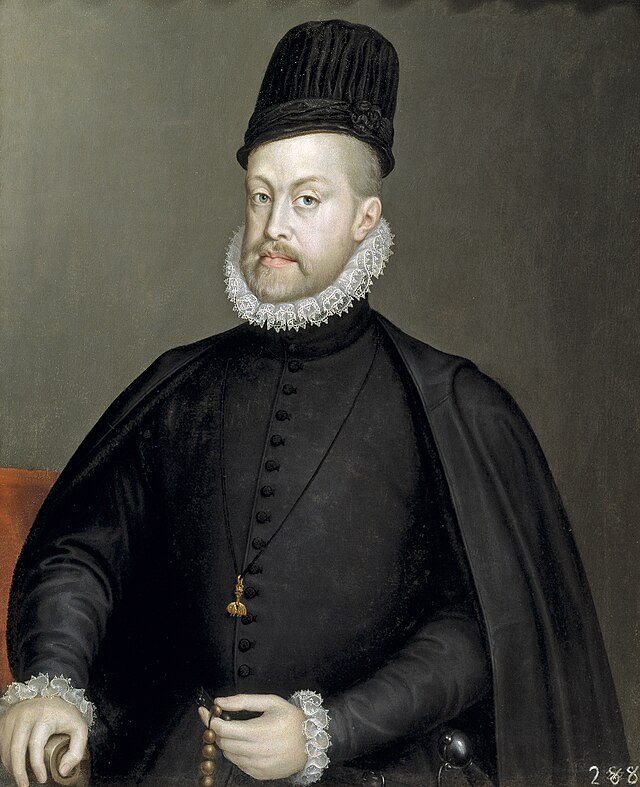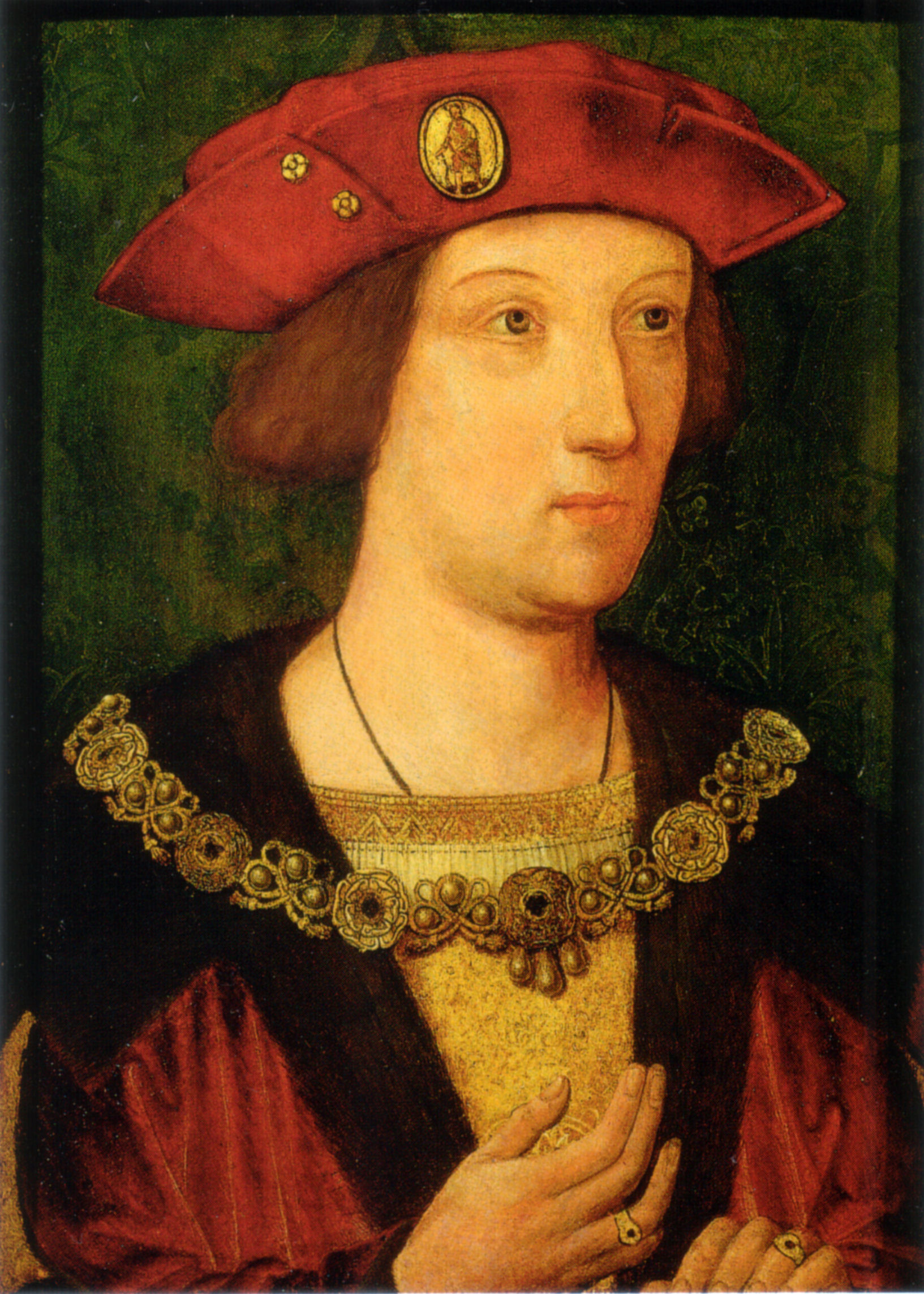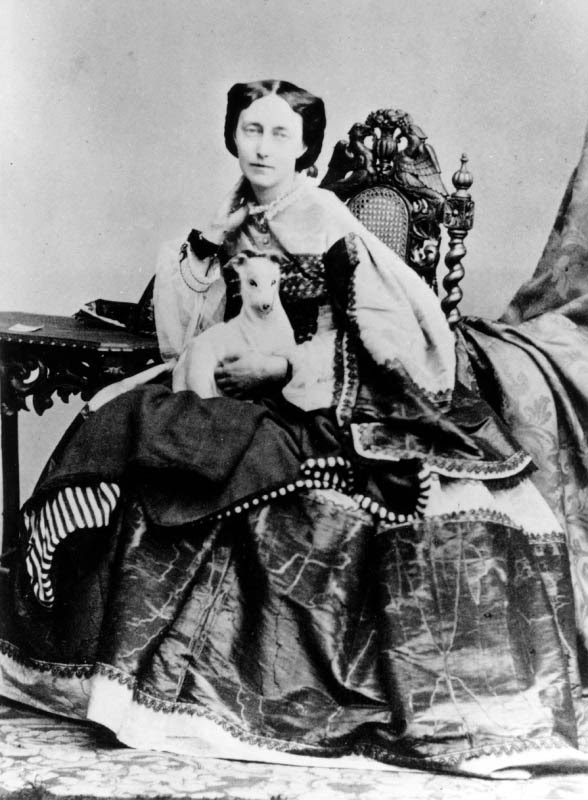© Unofficial Royalty 2023

King Philip II of Spain; Credit – Wikipedia
September 13, 1336 – Death of John of Eltham, Duke of Cornwall, son of King Edward II of England, in Perth, Scotland, buried in Westminster Abbey in London, England
In 1327, when John was eleven years old, his father King Edward II was forced to give up his crown in favor of his son 14-year-old son King Edward III, with his mother Isabella of France and Roger Mortimer, 3rd Baron Mortimer, 1st Earl of March acting as regents. King Edward II died in Berkeley Castle on September 21, 1327, probably murdered on the orders of Isabella and Mortimer. John was the heir to the English throne until 1330, when his nephew Edward, Prince of Wales, the first child of King Edward III, was born. King Edward III began marriage negotiations for his brother several times but none of the negotiations led to a betrothal. John had a brilliant military career, similar to the later military career of his nephew Edward, Prince of Wales, known as The Black Prince, who predeceased his father, and whose career ended just as suddenly. John of Eltham, 1st Earl of Cornwall died on September 13, 1336, in Perth, Scotland at the age of 20. The cause of his death is uncertain. There are references to John dying from a fever and dying in a skirmish with the Scots.
Unofficial Royalty: John of Eltham, Earl of Cornwall
September 13, 1410 – Death of Isabella of Valois, Queen of England, second wife of King Richard II of England, at Château de Blois in Blois, France, buried at the Church of the Celestines in Paris, France
Soon after the death of his first wife Anne of Bohemia in 1394, the childless King Richard II of England began a search for a new wife. He turned to France seeking an alliance and in 1397 a marriage was arranged between Isabella, a daughter of King Charles VI of France, and Richard who was 22 years older than his bride. Isabella lived apart from Richard at Windsor Castle. Richard visited her frequently and a strong affection developed between the partners of this unconsummated marriage. In 1399, Richard II was deposed by his cousin who then reigned as King Henry IV. Richard was imprisoned at Pontefract Castle in Yorkshire where he died on or around February 14, 1400. Eventually, Isabella’s return to France was arranged and she left England on July 1, 1401. Isabella married her cousin Charles of Orléans in 1406. At the age of 19, Isabella died a few hours after giving birth to her only child.
Unofficial Royalty: Isabella of Valois, Queen of England
September 13, 1598 – Death of King Felipe II of Spain at the Royal Site of San Lorenzo de El Escorial in San Lorenzo de El Escorial, Spain; buried at the Royal Site of San Lorenzo de El Escorial
Physically exhausted after 40 years of ruling, Felipe’s father Charles V, Holy Roman Emperor abdicated in 1555 and retired to the peace of a monastery, where he died three years later. Upon Charles’ abdications, the Holy Roman Empire was inherited by his younger brother Ferdinand, who had already been given the Austrian lands in 1521. The Spanish Empire, including the possessions in the Netherlands and Italy, was inherited by Felipe. Felipe married four times (one of his wives was Queen Mary I of England), was a widower four times, and had children with three of his wives. Toward the end of his life, Felipe’s health suffered. In 1595, gout was causing him severe pain, making him nearly immobile, and a special wheelchair was made for him. He also suffered from recurring episodes of malaria. During the last three months of his life, Felipe was bedridden and in great agony. He died at the age of 71 in his chambers at the El Escorial.
Unofficial Royalty: King Felipe II of Spain
September 13, 1612 – Death of Karin Månsdotter, Queen of Sweden, mistress and then wife of King Eric XIV of Sweden, in Finland; buried at the Cathedral of Turku, Finland
Karin Månsdotter was one of several mistresses of Erik XIV, King of Sweden, and then briefly his Queen Consort. Erik had suffered from mental health issues and from 1563 onwards these issues worsened. His decisions became more illogical and he exhibited violent behavior. Starting early on in her relationship with Erik, courtiers used Karin to intercede with Erik. Due to Erik’s behavior and his morganatic marriage to Karin, his younger half-brothers led a revolt against Erik with the support of many nobles that ended in his removal as King of Sweden in 1568. Erik and Karin were imprisoned but their children were initially placed in the care of Queen Dowager Katherina Stenbock, the third wife and widow of Erik’s father. In 1570, the children were returned to their parents. Karin gave birth to two children in captivity, both of whom died young. In 1573, Karin and her children were separated from Erik to prevent the birth of any more children. They were taken to Turku Castle in Finland where they remained under house arrest. After Erik died in 1577, Karin was released. King Johan III of Sweden granted Karin the royal estate Liuksiala Manor in Kangasala, Finland, where she lived comfortably for the rest of her life.
Unofficial Royalty: Karin Månsdotter, Queen of Sweden
September 13, 1820 – Death of Adelheid of Anhalt-Bernburg-Schaumburg-Hoym, first wife of the future Grand Duke August I, in Oldenburg, Duchy of Oldenburg, now in Lower Saxony, Germany; buried in the Ducal Mausoleum at Saint Gertrude’s Cemetery in Oldenburg
In 1817, Adelheid married the then Duke August of Oldenburg. The couple had two daughters including Amalia who married Prince Otto of Bavaria, later King of Greece. Adelheid died suddenly at the age of 20. Five years after her death, her husband married her youngest sister Ida.
Unofficial Royalty: Adelheid of Anhalt-Bernburg-Schaumburg-Hoym, Duchess of Oldenburg
September 13, 1848 – Death of Maria Isabella of Spain, Queen of the Two Sicilies, 2nd wife of Francesco I, King of the Two Sicilies, at the Palace of Portici in Portici, Kingdom of the Two Sicilies, now in Italy; buried at the Basilica of Santa Chiara in Naples.
The daughter of Carlos IV, King of Spain, 13-year-old Maria Isabella married her 25-year-old cousin Francesco I, King of the Two Sicilies. Maria Isabella had a four-year-old stepdaughter from her husband’s first marriage. As a 15-year-old, Maria Isabella gave birth to her first child who was to be followed by eleven more children over the next twenty-three years. Unusual for the time, all twelve survived childhood. Maria Isabella was only 41-year-old when her husband died in 1830 and despite being overweight, she was still attractive and had relationships with younger handsome servants. Maria Isabella wanted to marry again and her son Ferdinando II provided her with a list of acceptable young nobles as potential husbands. In 1839, 50-year-old Maria Isabella married 34-year-old Count Francesco del Balzo but he was not allowed to be at court with Maria Isabella. The couple withdrew from court and moved to the Royal Palace of Capodimonte in Naples, Kingdom of the Two Sicilies, now in Italy.
Unofficial Royalty: Maria Isabella of Spain, Queen of the Two Sicilies
September 13, 1863 – Birth of Ernst II, Prince of Hohenlohe-Langenburg in Langenburg, Principality of Hohenlohe-Langenburg, now in Baden-Württemberg, Germany
Full name: Ernst Wilhelm Friedrich Carl Maximilian
In 1896, Ernst married Princess Alexandra, the daughter of Prince Alfred, Duke of Edinburgh and Duke of Saxe-Coburg and Gotha, and a granddaughter of Queen Victoria. Ernst and Alexandra had five children including Gottfried, Prince of Hohenlohe-Langenburg who married Princess Margarita of Greece and Denmark, a sister of Prince Philip, Duke of Edinburgh. In 1900, Ernst’s father-in-law Prince Alfred, Duke of Edinburgh and Duke of Saxe-Coburg and Gotha died, and the ducal throne of Saxe-Coburg and Gotha passed to Alexandra’s cousin, Charles Edward, Duke of Albany. Because Charles Edward was just 16 at the time, Ernst was appointed as Regent until the new Duke reached his majority in 1905.
Unofficial Royalty: Ernst II, Prince of Hohenlohe-Langenburg
September 13, 1877 – Death of Maria Anna of Bavaria, Queen of Saxony, 2nd wife of King Friedrich August II of Saxony, in Dresden, Kingdom of Saxony, now in Saxony, Germany; buried in the Wettin Crypt at Dresden Cathedral
In 1833, Maria Anna, a daughter of King Maximilian I Joseph of Bavaria, married Crown Prince Friedrich August of Saxony but they had no children. Three years later, she became Queen of Saxony upon her husband’s accession to the throne. Maria Anna founded a women’s association to help combat the famines which were plaguing parts of Saxony. This association continued to exist until the early 1930s. In 1854, King Friedrich August II was killed in an accident while traveling in Tyrol, Austria. Queen Maria Anna had a chapel built on the site, which was dedicated a year later. She survived her husband by 23 years, dying at the age of 72.
Unofficial Royalty: Maria Anna of Bavaria, Queen of Saxony
September 13, 1892 – Birth of Princess Viktoria Luise of Prussia, Princess of Hanover, Duchess of Brunswick, daughter of Wilhelm II, German Emperor and King of Prussia, at Marmorpalais in Potsdam, Kingdom of Prussia, now in Brandenburg, Germany
Full name: Viktoria Luise Adelheid Mathilde Charlotte
Viktoria Luise was the youngest child of the seven children and the only daughter of Wilhelm II, German Emperor and King of Prussia. Through her father, she was a great-granddaughter of Queen Victoria. In 1913, Viktoria Luise married Ernst August III, Duke of Brunswick. Their wedding was one of the largest gatherings of royalty in Germany since the establishment of the German Empire in 1871. It would also be one of the last large social events before World War I, attended by 1,200 guests, including the British King and Queen and the Russian Emperor and Empress.
Unofficial Royalty: Princess Viktoria Luise of Prussia, Princess of Hanover, Duchess of Brunswick
September 13, 1918 – Death of Eduard, Duke of Anhalt in Berchtesgaden, Kingdom of Bavaria, now in Bavaria, Germany; buried in the Dessau Mausoleum in Dessau, Duchy of Anhalt, now in Saxony-Anhalt, Germany. In 1958, the remains of members of the House of Anhalt were removed from the Ducal Mausoleum secretly by night for political reasons (Dessau was then in Communist East Germany) and reburied in the Ziebigker Cemetery in Dessau in a common grave, marked only by a simple wooden cross. In 2019, Eduard’s remains were moved a second time and reinterred in the Marienkirche in Dessau, the traditional burial site of the Dukes of Anhalt-Dessau dating back to the 15th century. The Marienkirche was destroyed during World War II and has since been rebuilt.
Eduard, Duke of Anhalt ruled for less than five months, just before the end of World War I and the end of the German Empire. Eduard became Duke of Anhalt upon the death of his older brother, Friedrich II, on April 21, 1918. Less than five months later, on September 13, 1918, Eduard died in Berchtesgaden, Kingdom of Bavaria, now in the German state of Bavaria. He was succeeded by his son Joachim Ernst. As Joachim Ernst was not yet of age, Eduard’s brother Aribert served as Regent. At the end of World War I, Aribert abdicated on Joachim Ernst’s behalf on November 12, 1918.
Unofficial Royalty: Eduard, Duke of Anhalt
This article is the intellectual property of Unofficial Royalty and is NOT TO BE COPIED, EDITED, OR POSTED IN ANY FORM ON ANOTHER WEBSITE under any circumstances. It is permissible to use a link that directs to Unofficial Royalty.










